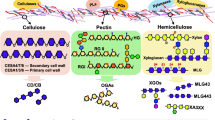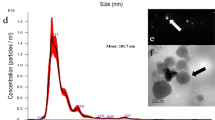Abstract
Fusarium oxysporum f. sp. vasinfectum penetration hyphae infect living cells in the meristematic zone of cotton (Gossypium barbadense L.) roots. We characterized wall modifications induced by the fungus during infection of the protodermis using antibodies against callose, arabinogalactan-proteins, xyloglucan, pectin, polygalacturonic acid and rhamnogalacturonan I in high-pressure frozen, freeze-substituted root tissue. Using quantitative immunogold labelling we compared the cell walls before and after hyphal contact, cell plates with plasmodesmata during cytokinesis, and wall appositions induced by fungal contact. In the already-existing wall, fungal contact induced only minor modifications such as an increase of xyloglucan epitopes. Wall appositions mostly exhibited epitopes similar to the cell plate except that wall appositions had a much higher callose content. This study shows that wall appositions induced by Fusarium oxysporum hyphae are the result of normal cell wall synthesis and the addition of large amounts of callose. The appositions do not stop fungal growth.
Similar content being viewed by others
Abbreviations
- AG:
-
arabinogalactan
- AGP:
-
arabinogalactan glycoprotein
- HRGP:
-
hydroxyproline-rich glycoprotein
- RGI:
-
rhamnogalacturonan I
- XG:
-
xyloglucan
References
Aist JR, Bushnell WR (1991) Invasion of plants by powdery mildew fungi, and cellular mechanisms of resistance. In: Cole TG, Hoch HC (eds) The fungal spore and disease initiation in plants and animals. Plenum Press, New York, pp 321–345
Balestrini R, Romera C, Puigdomenech P, Bonfante P (1994) Location of a cell-wall hydroxyproline-rich glycoprotein, cellulose and β-1,3-glucans in apical and differentiated regions of maize mycorrhizal roots. Planta 195: 201–209
Bohlmann H, Apel K (1991) Thionins. Annu Rev Plant Physiol Plant Mol Biol 42: 227–240
Bonfante-Fasolo P, Vian B, Perotto S, Faccio A, Knox JP (1990) Cellulose and pectin localization in roots of mycorrhizal Allium porrum: labeling continuity between host cell wall and interfacial material. Planta 180: 537–547
Bonfante-Fasolo P, Peretto R, Perotto S (1992) Cell surface interactions in endomycorrhizal symbiosis. In: Callow JA, Green JR, (eeds) Perspectives in plant cell recognition. Cambridge University Press, Cambridge, pp 239–255
Brisson LF, Tenhaken R, Lamb C (1994) Function of oxidative cross-linking of cell wall structural proteins in plant disease resistance. Plant Cell 6: 1703–1712
Bushnell WR (1984) Structural and physiological alterations in susceptible host tissue. In: Bushnell WP, Roelfs AP (eds) The cereal rusts. Academic Press, Inc., Orlando, Florida, pp 477–507
Carpita NC, Gibeaut DM (1993) Structural models of primary cell walls in the flowering plants: consistency of molecular structure with the physical properties of the walls during growth. Plant J 3: 1–30
Driouich A, Levy S, Staehelin A, Faye L (1994) Structural and functional organization of the Golgi apparatus in plant cells. Plant Physiol Biochem 32: 731–749
Esquerré-Tugayé MT, Lafitte C, Mazau D, Toppan AT (1979) Cell surfaces in plant-microorganism interactions. II Evidence for the accumulation of hydroxyproline-rich glycoproteins in the cell wall of diseased plants as a defense mechanism. Plant Physiol 64: 320–326
Freytag S, Arabatzis N, Hahlbrock K, Schmelzer E (1994) Reversible cytoplasmic rearrangements precede wall apposition, hypersensitive cell death and defence-related gene activation in potato/ Phytophthora infestans interactions. Planta 194: 123–135
Gibeaut DM, Carpita NC (1994) Biosynthesis of plant cell wall polysaccharides. FASEB J 8: 904–915
Gollote A, Gianinazzi-Pearson V, Giovannetti M, Sbrana C, Alvio L, Gianinazzi S (1993) Cellular localization and cytochemical probing of resistance reactions to arbuscular mycorrhizal fungi in a ‘locus a’ myc− mutant of Pisum sativum L. Planta 191: 122–122
Hächler H, Hohl HR (1984) Temporal and spatial distribution patterns of collar and papillae wall appositions in resistant and susceptible tuber tissue of Solanum tuberosum infected by Phytophthora infestans. Physiol Plant Pathol 24: 107–118
Hayat MA (1975) Positive staining for electron microscopy. Van Nostrand Rheinhold Company, New York
Heath MC (1972) Ultrastructure of host and nonhost reactions to cowpea rust. Phytopathology 62: 27–38
Herman EM, Lamb CJ (1992) Arabinogalactan-rich glycoproteins are localized on the cell surface and in intravacuolar multivesicular bodies. Plant Physiol 98: 264–272
Hohl HR, Suter E (1976) Host parasite interfaces in a resistant and susceptible cultivar of Solanum tuberosum inoculated with Phytophthora infestans: leaf tissue. Can J Bot 54: 1956–1970
Homblé F, Foissner I (1993) Electron microscopy and electrophysiology of local cell wall formation in Chara corallina. Plant Cell Physiol 34: 1283–1289
Hoson T (1991) Structure and function of plant cell walls: immunological approaches. Int Rev Cytol 130: 233–268
Hussey RS, Mims CW, Wescott SW (1992) Immunocytochemical localization of callose in root cortical cells parasitized by the ring nematode Criconemella xenoplax. Protoplasma 171: 1–6
Iiyama K, Lam TB, Stone BA (1994) Covalent cross-links in the cell wall. Plant Physiol 104: 315–320
Kauss H (1995) Callose synthesis. In: Smallwood M, Knox P, Bowles DJ (eds) Membranes: Specialized functions in plant cells. JAI Press, In press
Knox JP (1992) Molecular probes for the plant cell surface. Protoplasma 167: 1–9
Knox JP, Day S, Roberts K (1989) A set of cell surface glycoproteins forms an early marker of cell position, but not cell type, in the root apical meristem of Daucus carota. Development 106: 47–56
Knox JP, Linstead PJ, King J, Cooper C, Roberts K (1990) Pectin esterification is spatially regulated both within cell walls and between developing tissues of root apices. Planta 181: 512–521
Kunoh H (1982) Primary germ tubes of Erysiphe graminis conidia. In: Asada Y (ed) Plant infection: the physiological and biochemical basis. Japan Sci Soc Press, Tokyo/Berlin, pp 45–59
Levy S, Staehelin A (1992) Synthesis, assembly and function of plant cell wall macromolecules. Curr Opin Cell Biol 1992: 856–862
Lucas WJ, Ding B, Van der Schoot C (1993) Plasmodesmata and the supracellular nature of plants. New Phytol 125: 435–476
Mendgen K, Welter K, Scheffold F, Knauf-Beiter G (1991) High pressure freezing of rust infected plant leaves. In: Mendgen K, Leseman DE (eds) Electron microscopy of plant pathogens. Springer Verlag, Berlin Heidelberg, pp 31–41
Moore PJ, Staehelin LA (1988) Immunogold localization of the cell-wall-matrix polysaccharides rhamnogalacturonan I and xyloglucan during cell expansion and cytokinesis in Trifolium pratense L.; implication for secretory pathways. Planta 174: 433–445
Moore PJ, Swords KMM, Lynch MA, Staehelin LA (1991) Spatial organization of the assembly pathways of glycoproteins and complex polysaccharides in the Golgi apparatus of plants. J Cell Biol 112:589–602
Mueller WC, Morgham AT, Roberts EM (1994) Immunocytochemical localization of callose in the vascular tissue of tomato and cotton plants infected with Fusarium oxysporum. Can J Bot 72: 505–509
Northcote DH, Davey R, Lay J (1989) Use of antisera to localize callose, xylan and arabinogalactan in the cell-plate, primary and secondary walls of plant cells. Planta 178: 353–366
Pennell RI (1992) Cell surface arabinogalactan proteins, arabinogalactans and plant development. In: Callow JA, Green JR (eds) Perspectives in plant recognition. Cambridge University Press, Cambridge, pp 105–121
Pennell RI, Knox JP, Scofield GN, Selvendran RR, Roberts K (1989) A family of abundant plasma membrane-associated glycoproteins related to the arabinogalactan proteins is unique to flowering plants. J Cell Biol 108: 1967–1977
Puhlmann J, Bucheli E, Swain MJ, Dunning N, Albersheim P, Darvill AG, Hahn MG (1994) Generation of monoclonal antibodies against plant cell-wall polysaacharides. Plant Physiol 104: 699–710
Rae A, Bonfante-Fasolo P, Brewin N (1992) Structure and growth of infection threads in the legume symbiosis with Rhizobium leguminosarum. Plant J 2(3): 385–395
Ride JP, Pearce RB (1979) Lignification and papilla formation at sites of attempted penetration of wheat leaves by non-pathogenic fungi. Physiol Plant Path 15: 79–92
Roberts K (1994) The plant extracellular matrix: in a new expansive mood. Curr Op Cell Biol 6: 688–694
Rodriguez-Gálvez E, Mendgen K (1995) The Infection process of Fusarium oxysporum in cotton root tips. Protoplasma, In press
Russo VM, Bushnell WR (1989) Responses of barley cells to puncture by microneedles and to attempted penetration by Erysiphe graminis f. sp. hordei system. Can J Bot 67: 2912–2921
Sargent C, Gay JL (1977) Barley epidermal apoplast structure and modification by powdery mildew contact. Physiol Plant Pathol 11: 195–205
Sherrier DJ, VandenBosch KA (1994) Localization of repetitive proline-rich proteins in the extracellular matrix of pea root nodules. Protoplasma 183: 148–161
Sherwood RT, Vance CP (1982) Initial events in the epidermal layer during penetration. In: Asada Y (ed) Plant infection: The physiological and biochemical basis. Japan Sci Soc Press/Springer Verlag, Tokyo/Berlin, pp 27–44
Showalter AM (1993) Structure and function of plant cell wall proteins. Plant Cell 5: 9–25
Smart MG (1991) The plant cell wall as a barrier to fungal invasion. In: Cole GT, Hoch HC (eds) The fungal spore and disease initiation in plants and animals. Plenum Press, New York and London, pp 47–66
Stark-Urnau M, Mendgen K (1995) Sequential deposition of plant gycoproteins and polysaccharides into the host-parasite interface of Uromyces vignae and Vigna sinencis. Evidence for endocytosis and secretion. Protoplasma 186: 1–11
Steffan W, Kovác P, Albersheim P, Darvill AG, Hahn MG (1995) Characterization of a monoclonal antibody that recognizes an arabinosylated (1-6)-β-d-galactan epitope in plant complex carbohydrates. Carbohydr Res, In press
Turner A, Wells B, Roberts K (1994) Plasmodesmata of maize root tips: structure and composition. J Cell Sci 107: 3351–3361
Xu H, Mendgen K (1994) Endocytosis of 1,3-β-glucans by broad bean cells at the penetration site of the cowpea rust fungus (haploid stage). Planta 195: 282–290
Zhang GF, Driouich A, Staehelin A (1993) Effect of monensin on plant Golgi: re-examination of the changes in cisternal architecture and function activities of the Golgi apparatus of sycamore suspension-cultured cells. J Cell Sci 104: 819–831
Zhang GF, Staehelin LA (1992) Functional compartmentation of the Golgi apparatus of plant cells. Plant Physiol 99: 1070–1083
Author information
Authors and Affiliations
Additional information
We thank Dr. Holger Deising and Dr. Matthias Hahn (Lehrstuhl für Phytopathologie, Universität Konstanz, Konstanz, Germany) for reading the manuscript. We thank Dr. Michael Hahn (Complex Carbohydrate Research Center, University of Georgia, Athens, USA) for providing the antibodies CCRC-M1, CCRC-M2 and CCRC-M8 and Dr. Paul Knox (Centre for Plant Biochemistry and Biotechnology, University of Leeds, UK) for providing the antibodies JIM 5 and JIM 7. The first author is grateful to the Deutsche Akademische Austauschdienst for a scholarship.
Rights and permissions
About this article
Cite this article
Rodríguez-Gálvez, E., Mendgen, K. Cell wall synthesis in cotton roots after infection with Fusarium oxysporum . Planta 197, 535–545 (1995). https://doi.org/10.1007/BF00196676
Received:
Accepted:
Issue Date:
DOI: https://doi.org/10.1007/BF00196676




